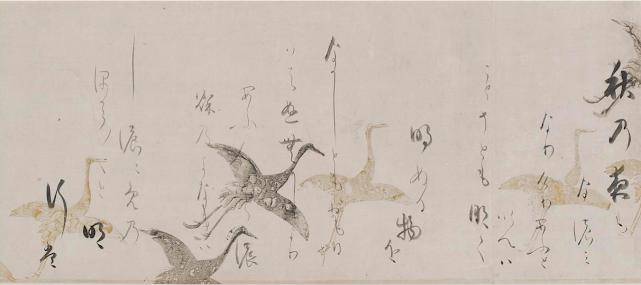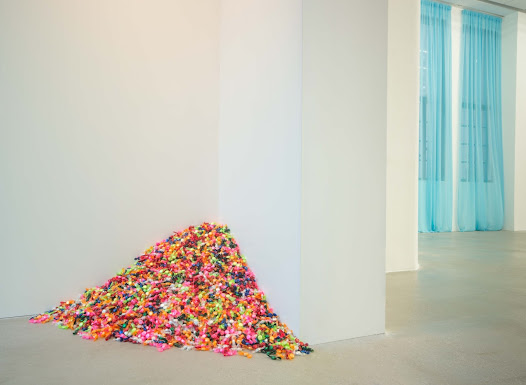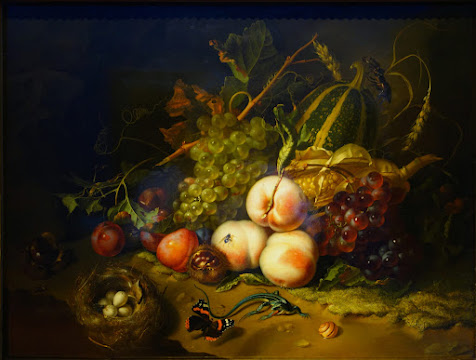Japan's Edo period has been referred to as their "early-modern" era in the arts. Edo, a city in Japan, which is now modern day Tokyo, was the center of the blossoming art style. While Edo period is a categorical time for the art style, due to the diversity and length of this period, there are multiple sub-periods. The Edo period spanned from 1615-1868. This was largely due to the ruling in Japan bringing prosperity and peace for the people. This is reflected in much of the art being produced during this time.

Above is a collaboration art work titled Poems from the Kokin wakashū by two prominent artists, Tawaraya Sōtatsu and Hon’ami Kōetsu. This work is a handscroll created on paper, with ink, gold, silver, and mica. Tawaraya Sōtatsu was a painter and contributed to the painting in this piece, and Hon’ami Kōetsu was a calligrapher and ceramist. The painting/calligraphy/poem is an important aspect of the Edo period, as this was when there was an increase in visual vocabulary incorporated into other art mediums. I think this is so appealing to me because of the simplistic beauty that Japanese art seems to achieve time and time again. Japan's script is so beautiful alone, and I think the artists' choice to write the poem vertically adds to the visual appeal. The simple crane silhouettes in the back are eye catching, but don't overpower the script, which is one reason it works so well. The use of gold and silver in the cranes creates an elegant feel.

The above art is titled Red and White Plum Blossoms by Ogata Kōrin. This art was a pair of bifold screens, made using gold leaf and color on paper. This was made in the early eighteenth century. In this image we see two flowering trees on each side of the river. One has white blossoms and the other has red. My eye is definitely drawn from the left of the white plum blossoms up through the river and then back down to the red plum blossoms. I really love the use of the swirls in the inky river. It feels threatening and dangerous, while the beauty and liveliness of the tree blossoms on either side is a strong contrast. The use of gold leaf is one of the reasons I chose to exhibit this piece in my blog. I couldn't help but finding myself comparing this to the extensive amount of gold leaf used in many 14th century European biblical paintings. Obviously, majority of Japanese do not practice Christianity, but it is almost as if nature holds that same importance within their art.

The work above is a porcelain coffee pot from Japan. It is titled "Coffee Pot" and it is unknown who created this work. It is believed to be made sometime between 1650 and 1675. It is decorated with blue underglaze and then mounted with silver embellishments. While this was an odd shape in Japanese porcelain, this was specifically made for European export. Because there was no familiarity with coffee pots in Japan, the Dutch provided models for Japanese potters to copy off of. I was particularly interested in this piece of pottery because of the ties to Europe that it has. While these countries differed in such dramatic art styles, there was still influence being made from both ends. I think this, as well as most any Japanese pottery, is so beautiful. The bright blue on the white porcelain is striking, and I love the style that they decorate with. It looks soft and unfocused, similar to watercolor. I am also a fan of the subject matter, it is beautiful to see nature depicted in household serving ware like this.
Bibliography:







Hi Lauren, I just finished commenting another classmate's blog that they also did on Japanese Art they did something different. I have mentioned in the other comment I made that my favorite Japanese Art are pieces that has poems written on them. It just makes the art piece so meaningful, like it is telling the story behind the piece. With the "White and Red Plum Blossoms," when I first looked at it, I could only think about how rich it looks with all the gold surrounding it. These are the type of art pieces that look like it would belong to an emperor palace. Although with all the gold surrounding it, what got my attention more are the two blossom trees and how simple but beautiful they look in an art piece that surrounds itself with gold. And with the "Coffee Pot," it still amazes me how people in the past can use these beautiful and delicate things for everyday use. Even though the maker on uses one color, they use the blue in such a creative way that we can still see the details put on it.
ReplyDeleteI like how you featured the coffee pot! So far I've only chosen to cover paintings, so I like getting to see works of art such as statues and pottery. As you mentioned about "Poems from the Kokin wakashū", I think it's fascinating to see how many forms of art were amalgamated into one. Poetry, calligraphy, and painting all come together to make the art. In spite of how many aspects there are, the art still remains simple and visually appealing as you mention. I'd also never seen art such as "Red and White Plum Blossoms" which come together as two folding screens to create the full picture. The bifurcation allows the artist to contrast two things, even something as simple as red and white plums. Lastly, I like the coffee pot a lot! The two things I've always synonymized with porcelain is dolls and Chinese (or in this case Japanese) ceramics, and with the attention to detail this shows it's no wonder why. Seeing a Japanese take on something that at the time was purely a European necessity is pretty interesting, and it makes sense why it seems to have such an odd design as you mention. It's cool to see how things like the food and drink of a time can influence the design of things such as ceramics.
ReplyDeleteWhat a great topic you have, I did the same one and it is neat to see it from another perspective. I find that Japan has some really interesting and stunning artworks. The one you chose I haven’t seen before and it is neat that two artists did it, one did the painting and the other the calligraphy. I found another artist who did one that I think is neat the website is LACMA and the art is called The Sound of One Hand. I really enjoy seeing calligraphy and a picture of the same art.
ReplyDeletehttps://www.lacma.org/art/exhibition/sound-one-hand-paintings-and-calligraphy-zen-master-hakuin